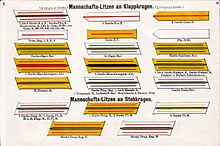Braid

In textile technology, a strand is a two-dimensional mesh .
Nowadays, strands are rarely used because they are considerably more expensive than woven tapes or cords . A strand can be used to decorate and to border and trimmed items of clothing, but less for reinforcement .
They are also used as trimmings .
Uniforms
Litz wire was used particularly often in uniforms of the 19th century and traditional costumes as a decorative and delimiting element.
In the old army , litz wires were originally reserved for guard units . On March 22nd, 1897, on the occasion of the old emperor's 100th birthday , Kaiser Wilhelm II awarded the grenadier regiment "King Wilhelm I." (2nd West Prussian) No. 7 Litzen. Up until 1918, other grenadier regiments and other units were also marked with braids.
In principle there were three main forms of stranded wire in the old army up to the transitional army :
- Old Prussian strands (old type strands with or without a mirror)
- Simple strands (simple chapel strands)
- Double strands (double chapel strands)
It was not until 1921 that double strands became common for the formation of the Reichswehr transitional army , which were then also referred to as double piston strands.
Even today, the various types of troops in the German army are identified by small colored strands that are placed on the shoulder flap (for example, green for tank grenadiers or hunters , dark blue for the medical service or lemon yellow for the telecommunications force ), for more details see under weapon colors .
Web links
literature
- Paul Pietsch: The formation and uniform history of the Prussian army 1808-1914 . 2 volumes. Verlag HG Schulz, 1963.
- Jürgen Kraus: The field-gray uniform of the German army 1907–1918. 2 volumes. Biblio-Verlag, Osnabrück 1999, ISBN 3-7648-2533-2 .
Individual evidence
- ↑ Bund Deutscher Pioniere: Symbols of the Pioneer Troop ( Memento of the original from March 4, 2016 in the Internet Archive ) Info: The archive link was inserted automatically and has not yet been checked. Please check the original and archive link according to the instructions and then remove this notice.
- ^ War Ministry (Ed.): Royal Prussian Army Ordinance Sheet. ES Mittler & Sohn , Berlin March 22, 1897, Volume 31, Extra Edition, p. 7.
- ^ Paul Pietsch: The formation and uniforming history of the Prussian Army 1808-1914 , Volume 1 - foot troops, Verlag HG Schulz, 1963, pp. 28-29.
- ↑ Jürgen Kraus: The field-gray uniforms of the German army 1907-1918. Volume 1. Biblio-Verlag, Osnabrück 1999, ISBN 3-7648-2533-2 , pp. 152-154.
- ↑ Adolf Schlicht, Jürgen Kraus: The German Reichswehr: the uniforms and equipment of the German Reichsheer from 1919 to 1932 , Militaria Verlag, 2005, p. 88.
- ↑ See also an example for the NVA

